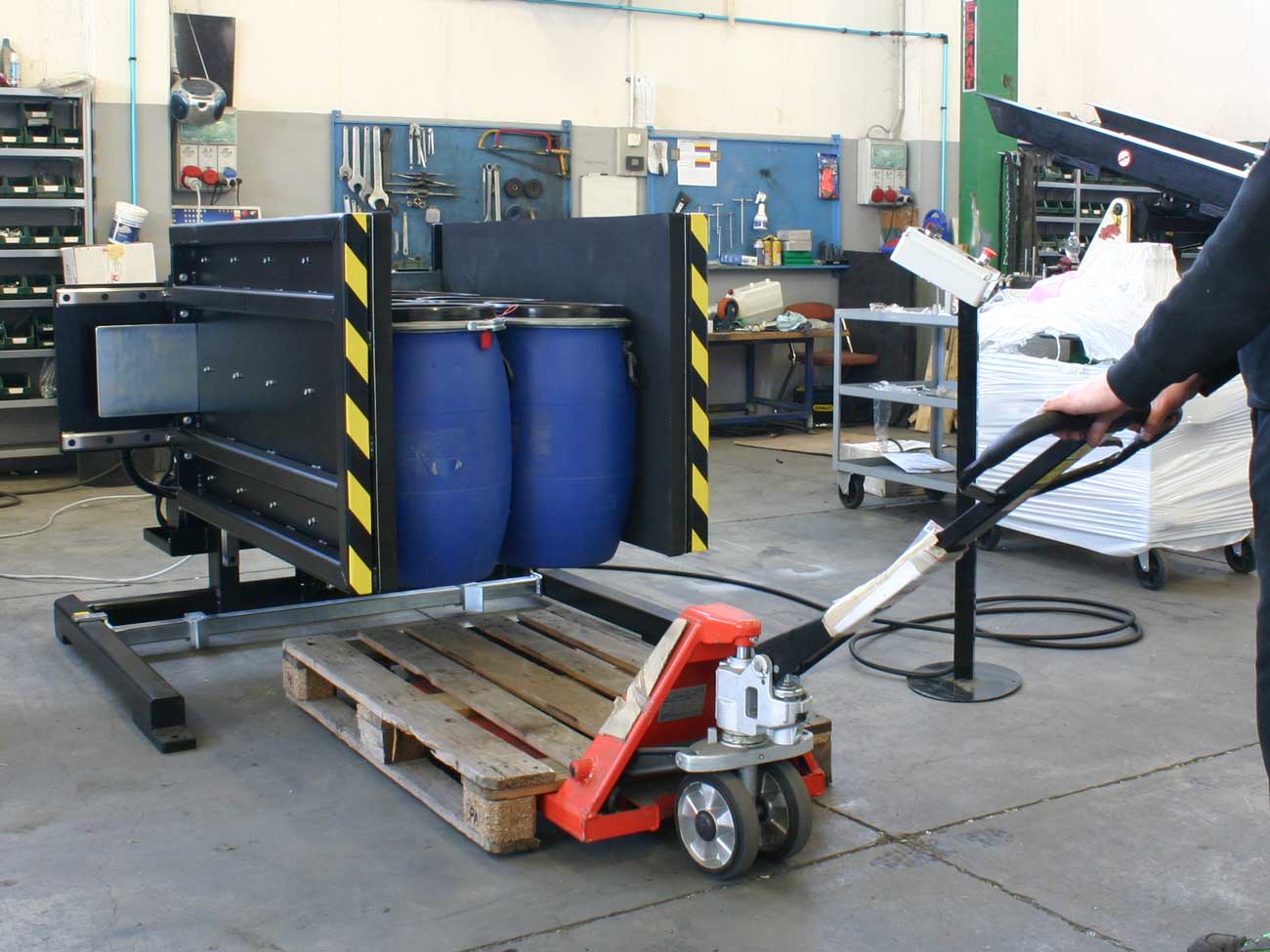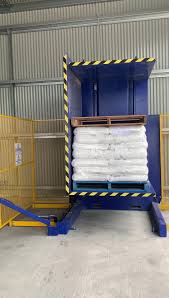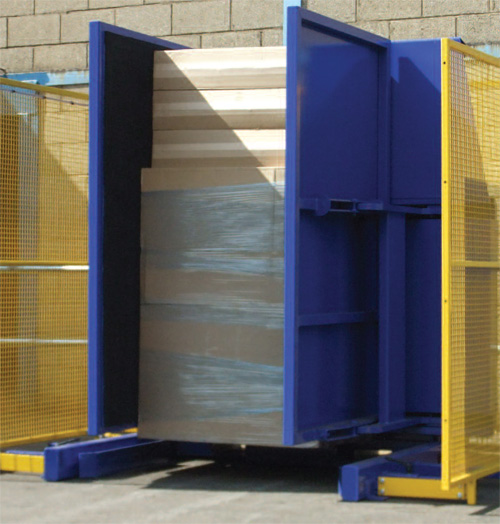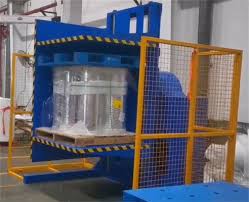Choosing the Right Pallet Inverter for South Korea's Demands in Smart Factory Trends and Industry 4.0 Upgrades
Are your logistics operations struggling to keep pace with your production line? In South Korea's advanced manufacturing landscape, manual pallet handling is a significant bottleneck. It slows down your entire process, creates safety hazards for your team, and leads to product damage. This inefficiency directly cuts into your profits and prevents your facility from reaching its full potential in the Industry 4.0 era. You need a solution that not only solves these problems but also integrates seamlessly into your smart factory vision, boosting efficiency and future-proofing your investment.
Choosing the right pallet inverter for South Korea’s smart factory goals means selecting a machine that offers automation, data connectivity, and robust construction. The ideal inverter should integrate with your existing Warehouse Management System (WMS) or Manufacturing Execution System (MES). It must be built with durable components to handle demanding industrial environments and minimize downtime. Look for features like programmable logic controllers (PLCs) for customized cycles, safety sensors that meet Korean safety standards, and energy-efficient motors to align with sustainability goals. This strategic choice transforms a simple piece of equipment into a key player in your Industry 4.0 upgrade.

I have walked the factory floors for over two decades, first as an engineer and now as a factory owner myself. I understand the pressure to modernize. The choices we make on equipment today define our competitiveness for the next decade. A pallet inverter isn't just about turning loads; it's about unlocking new levels of efficiency. Let’s explore how to select a machine that meets the specific demands of South Korea's dynamic market and your smart factory ambitions. We will break down the essential features, the potential for automation, and how this investment pays for itself.
How Can a Pallet Inverter Align with South Korea's Smart Factory Goals?
Your factory is filled with advanced CNC machines and robotic arms, yet pallets are still being switched by hand. This manual process feels out of place. It creates a data black hole in an otherwise connected system. This gap makes it impossible to track goods flow accurately, measure cycle times, and fully automate your internal logistics. You are missing a critical piece of the puzzle to achieve the seamless, data-driven operation that defines a true smart factory.
A modern pallet inverter aligns with smart factory goals by acting as a connected data point in your logistics chain. Equipped with PLC controls and IoT sensors, it can communicate directly with your MES and WMS. This integration allows for real-time tracking of pallet exchange cycles, automated task assignment, and the collection of valuable performance data. It transforms a manual, isolated task into an automated, transparent, and efficient part of your production flow, which is the core principle of Industry 4.0.

Dive Deeper: Integrating Pallet Inverters into the Digital Ecosystem
When I started my journey, the goal was simple: make a reliable machine. Today, that is not enough. For a market as advanced as South Korea, a machine must be more than just mechanically sound; it must be digitally fluent. It has to speak the language of your other systems. Integrating a pallet inverter is not just about plugging it in. It is about creating a dialogue between your logistics hardware and your management software.
The Role of PLC and System Integration
At the heart of a smart pallet inverter is its Programmable Logic Controller (PLC). Think of the PLC as the machine's brain. A basic inverter might have a simple controller for a fixed cycle. But for a smart factory, you need more.
- Customizable Cycles: Your facility handles different products with unique requirements. A sophisticated PLC allows you to program and save multiple cycle parameters. You can adjust clamping pressure for delicate goods, change the rotation speed, or add a vibration step to settle contents. This is all selectable from an HMI or triggered automatically by your WMS based on the product's barcode.
- MES/WMS Handshake: The real magic happens when the inverter "handshakes" with your MES. For example, when a finished pallet arrives from the production line, a scanner reads its label. The WMS identifies it needs to be switched to an export-compliant plastic pallet. It then sends a command to the automated guided vehicle (AGV) to transport it to the inverter. The WMS also tells the inverter which pre-programmed cycle to use. The inverter performs the task and sends a "task complete" signal back to the WMS. The system then directs the AGV to move the newly palletized goods to the shipping bay. This seamless flow eliminates manual decision-making and idle time.
Data: The Fuel of Industry 4.0
An integrated pallet inverter becomes a rich source of data. IoT sensors on the machine can monitor more than just cycle completion. They track motor temperature, hydraulic pressure, and the number of cycles performed. This data is invaluable for two key goals of any factory owner: visibility and predictive maintenance.
| Data Point Collected | Smart Factory Application | Benefit for Your Operation |
|---|---|---|
| Cycle Count | Throughput Analysis | Track hourly/daily productivity, identify bottlenecks. |
| Motor Current/Temp | Predictive Maintenance | Get alerts for potential motor failure before it happens. |
| Hydraulic Pressure | Quality Control | Ensure consistent clamping force, preventing product damage. |
| Fault Codes | Remote Diagnostics | Allow our technicians to diagnose issues remotely, reducing downtime. |
This data, when fed into your analytics platform, provides a clear picture of your end-of-line efficiency. It helps you transition from reactive repairs to a proactive, predictive maintenance strategy, directly supporting your goal of 95% equipment uptime.
What Key Features Maximize ROI and Minimize Maintenance?
You've invested heavily in new production machinery, but the support equipment is a constant headache. Older pallet transfer systems break down frequently, stopping your entire shipping department. Spare parts are hard to find, and maintenance is a messy, time-consuming job. Each hour of downtime costs you money and reputation. You need equipment that is not just a purchase, but a reliable, long-term investment with a clear return.
To maximize ROI and minimize maintenance, focus on three key features: robust construction, high-quality standard components, and operator-friendly design. Robust construction with heavy-gauge steel ensures the machine withstands industrial use for years. Using standard, globally recognized components for motors, hydraulics, and electronics means parts are easy to source, reducing downtime. An intuitive, simple-to-use interface reduces training time and minimizes errors, ensuring the machine runs efficiently from day one. These features combine to deliver a low total cost of ownership and a fast return on investment.

Dive Deeper: Deconstructing a Low-Maintenance, High-ROI Pallet Inverter
I learned a hard lesson early in my career as an engineer. A brilliantly designed machine is useless if it is not reliable. A client of mine once said, "Vincent, your machine must be as tough as my people." That stuck with me. In a steel mill or a busy distribution center, equipment takes a beating. The initial price of a machine is only one part of the story. The total cost of ownership is what truly matters to a business owner like you or me. Let's break down the tangible features that deliver that value.
Built to Last: The Importance of a Strong Frame
The foundation of any durable pallet inverter is its frame. It is the skeleton that holds everything together and absorbs the stress of daily operation.
- Material and Welding: We use heavy-gauge Q235 steel, which is equivalent to common structural steel grades known for strength. More importantly, our welders are certified, and we use robotic welding for critical joints. This ensures every weld is consistent and deep, preventing cracks and structural fatigue over the machine's lifetime. A poorly welded frame is a hidden liability that can lead to catastrophic failure.
- Surface Treatment: In many facilities, especially those with temperature fluctuations or exposure to chemicals, corrosion is the enemy. A simple coat of paint is not enough. Our process involves sandblasting to create a perfect surface for adhesion, followed by a multi-layer epoxy paint process. This creates a durable barrier that resists chipping, rust, and chemical damage, extending the machine's life and maintaining its value.
Smart Component Selection: The Key to Uptime
A machine is only as strong as its weakest part. That is why component selection is not a place to cut corners. Using non-standard or low-quality parts can turn a simple repair into a week-long shutdown while you wait for a proprietary part from overseas.
| Component | Our Standard Choice | Why It Matters for Your ROI |
|---|---|---|
| Motor | Siemens or SEW-Eurodrive | Globally recognized for reliability and efficiency. Easy to service or replace anywhere in the world, including South Korea. |
| Hydraulics | Parker or Yuken | Known for leak-resistant, high-performance valves and pumps. Reduces oil spills and maintenance needs. |
| PLC | Siemens or Allen-Bradley | Industry-standard controllers that your own maintenance team is likely already familiar with. Simplifies troubleshooting. |
| Bearings | SKF or FAG | Premium bearings that last longer under heavy loads, preventing premature failure of rotating parts. |
Choosing standard components means you are not locked into a single supplier for spare parts. Your local industrial supplier in Seoul or Busan will likely have these parts on the shelf. This is a crucial detail for minimizing downtime and keeping your lines running. This directly impacts your ability to hit that 95% uptime target.
How Do Pallet Inverters Impact Energy Efficiency and ESG Standards?
Energy prices are always fluctuating, making them a constant threat to your production budget. At the same time, pressure is mounting from the government and your customers to improve your environmental footprint. You are looking for solutions that tackle both challenges at once—cutting operational costs while improving your company's ESG (Environmental, Social, and Governance) score. Investing in new technology that is not energy-efficient feels like taking one step forward and two steps back.
Modern pallet inverters directly contribute to energy efficiency and ESG goals. They achieve this by using high-efficiency motors and smart hydraulic systems that only consume power when in operation, unlike older models that run continuously. By automating a manual task, they also improve worker safety and ergonomics, a key component of the "Social" aspect of ESG. Furthermore, by enabling the switch to reusable plastic or aluminum pallets, they help reduce wood waste and support a circular economy, boosting your "Environmental" credentials.

Dive Deeper: The Green and Safe ROI of Pallet Inverters
When I founded my own factory, I wasn't just thinking about profit. I was thinking about building a sustainable business. I saw how much waste—of energy, materials, and human effort—existed in traditional manufacturing. Helping clients reduce that waste has become a core part of our mission at SHJLPACK. A pallet inverter is a perfect example of how a single piece of equipment can create a positive impact across your entire operation, from your electricity bill to your safety record.
Engineering for Energy Efficiency
The goal of reducing unit energy consumption by 10% is ambitious but achievable. Your equipment choices play a huge role. An older pallet inverter with an oversized, standard-efficiency motor running all day can be an energy vampire. Here is how modern design makes a difference:
- High-Efficiency Motors: We use IE3 or even IE4 class motors as standard. An IE3 motor is up to 10% more efficient than an older IE1 motor. While the initial cost is slightly higher, the energy savings pay back the difference quickly, often within 18-24 months, depending on usage.
- Hydraulics on Demand: A major source of wasted energy in older hydraulic machines is a pump that runs constantly, even when the machine is idle. Our systems use a "power-on-demand" design. The hydraulic motor only activates during the clamping and rotation phases. During loading and unloading, it is off. This simple change can reduce the machine's idle energy consumption by over 90%.
- Regenerative Braking (Advanced Option): For high-throughput applications, some models can be equipped with regenerative systems. As the heavy load is lowered, the motor acts as a generator, capturing some of that kinetic energy and feeding it back into your facility's power grid. This is the same technology used in electric vehicles and is the cutting edge of industrial energy efficiency.
Improving Your ESG Score: Beyond the Environment
ESG is not just about being green. The "S" for Social is equally important, and in manufacturing, it largely comes down to worker safety and well-being.
- Ergonomics and Safety: Manually lifting and restacking goods from a pallet is a leading cause of musculoskeletal injuries in warehouses. These injuries lead to lost workdays, higher insurance premiums, and lower team morale. A pallet inverter eliminates this hazardous manual task entirely. Our machines are also equipped with safety light curtains, pressure-sensitive plates, and physical guarding that meet or exceed international safety standards, including those relevant in South Korea. This demonstrates a clear commitment to your employees' health.
- Supporting the Circular Economy: The "E" for Environment is also about reducing waste. Many companies are moving away from single-use wooden pallets to durable, reusable plastic or metal pallets. A pallet inverter is the essential tool that makes this transition possible. It allows you to easily switch incoming goods from shipper pallets to your internal, reusable pallet pool. This reduces deforestation, lowers your waste disposal costs, and strengthens your company's circular economy story—a powerful message for environmentally-conscious customers.
What Level of Automation is Right for My Factory's Upgrade?
You see the potential of automation, but you are not sure where to start. A fully robotic, "lights-out" solution seems complex and expensive, but a simple standalone machine might not deliver the efficiency gains you need. You need to find the sweet spot—an automation solution that fits your current workflow, your budget, and your team's capabilities, while also providing a clear path for future upgrades. Making the wrong choice could mean overspending on features you do not use or underspending on a machine you will quickly outgrow.
The right level of automation depends on your specific throughput, existing infrastructure, and long-term goals. For lower volume operations or facilities just beginning their automation journey, a standalone, semi-automatic pallet inverter offers a fast ROI by eliminating manual labor. For high-volume distribution centers or smart factories with AGVs, a fully-automatic, in-line system that requires no operator intervention is the optimal choice. It integrates directly into your conveyor system for maximum efficiency and data connectivity.

Dive Deeper: Scaling Automation to Your Needs
During my time helping clients, I have seen both scenarios: a company buys a machine that is too simple and it creates a new bottleneck, and another buys a system so complex their team is intimidated by it. The goal is to match the technology to the task. At SHJLPACK, we don't just sell machines; we provide a total solution. That starts with understanding your unique operational needs to recommend the right level of automation. Let's compare the options.
Option 1: The Standalone Semi-Automatic Inverter
This is the most common entry point into pallet-handling automation. It is a perfect fit for facilities that need to improve safety and efficiency but are not yet ready for a fully integrated system.
- How it Works: A forklift operator brings a pallet and places it into the inverter. The operator then initiates the cycle using a simple push-button control panel. The machine clamps the load, rotates it, and the operator removes the original pallet. The process is then reversed.
- Best For:
- Operations with a throughput of up to 20 pallets per hour.
- Facilities where pallet exchange is needed in multiple locations.
- Companies taking their first step away from manual restacking.
- Key Benefit: It is a fast, focused solution to a specific problem. It immediately improves safety and is very easy for staff to learn. The ROI is often realized in less than 12 months through labor savings and reduced product damage.
Option 2: The Fully-Automatic In-Line System
This is the solution for the true smart factory. It is designed to work as part of a larger, integrated logistics system with zero manual interaction.
- How it Works: The pallet inverter is built directly into a roller or chain conveyor line. Pallets are fed into it automatically. Sensors detect the pallet's arrival, and the system communicates with the WMS to confirm the task. The exchange cycle runs automatically. The old pallet is ejected onto a separate conveyor or stacker, and the product on its new pallet continues down the line to the next station, such as a stretch wrapper or shipping bay.
- Best For:
- High-volume distribution centers, food and beverage plants, or pharmaceutical facilities.
- Operations with throughput needs of 25 to 60+ pallets per hour.
- Factories that already use AGVs and automated conveyor systems.
- Key Benefit: This system delivers maximum throughput and efficiency. It eliminates all labor from the pallet transfer process and provides a continuous, uninterrupted flow of goods. It is the ultimate expression of Industry 4.0 principles, turning a process into a seamless, data-rich flow.
| Feature | Semi-Automatic (Standalone) | Fully-Automatic (In-Line) |
|---|---|---|
| Throughput | 10-20 pallets/hour | 25-60+ pallets/hour |
| Labor Required | 1 Forklift Operator | 0 (Supervisory only) |
| Integration | Minimal (standalone) | Full MES/WMS Integration |
| Footprint | Flexible, can be moved | Fixed, part of a conveyor line |
| Best For | Safety improvement, initial automation | Maximum efficiency, smart factories |
Choosing between these is a strategic decision. It is a conversation about where your factory is today, and more importantly, where you and I see it going in the next five years.
My Insights on Choosing a Partner, Not Just a Supplier, for Your Industry 4.0 Journey
I remember the feeling of signing the purchase order for my factory's first major piece of equipment. It was more than just a transaction. It was a commitment. It was a bet on my own future. I needed to know that the company on the other end of that contract understood what was at stake. I wasn't just buying steel and motors; I was buying reliability, support, and expertise. I was buying a partnership.
Today, as I stand on the other side of that table, I carry that memory with me. Any company can sell you a machine. A true partner, however, invests in your success. They listen to your challenges—like the pressure of volatile energy costs in Mexico or the need to meet strict environmental standards. They work with you to configure a solution, not just sell a standard product. They are there for you during installation, training, and for the years of service that follow.
When you are making a critical investment to upgrade your facility, especially for something as foundational as your Industry 4.0 transformation, you are looking for that same level of commitment. You need a partner who has been in your shoes, who understands the pressure of meeting production targets and managing a P&L. You need someone who sees your success as their success.
My journey from engineer to factory owner gave me a unique perspective. It taught me that trust is the most valuable currency in this business. It is why we at SHJLPACK are so focused on sharing our knowledge and being transparent in everything we do. We want to be the partner I was looking for all those years ago. Because we know that the right equipment, backed by the right partnership, is the foundation for growth and success.
Conclusion
Choosing the right pallet inverter is a strategic move toward a safer, more efficient, and smarter factory. It’s an investment in your future competitiveness in a demanding global market.




